Retail sales of layered verrine-style desserts in France are estimated at USD 129 million in 2025, with projections indicating a rise to USD 324 million by 2035, reflecting a CAGR of approximately 9.6% over the forecast period.
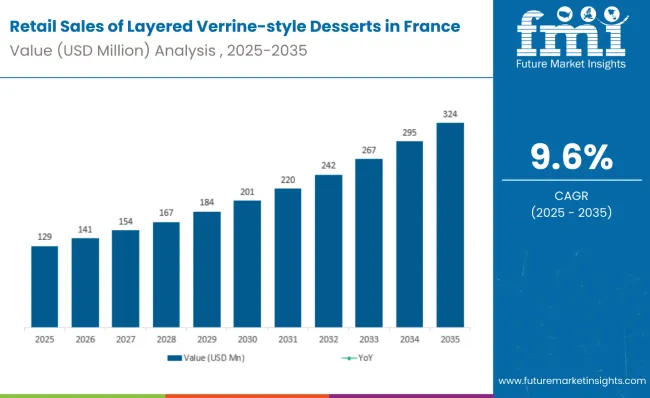
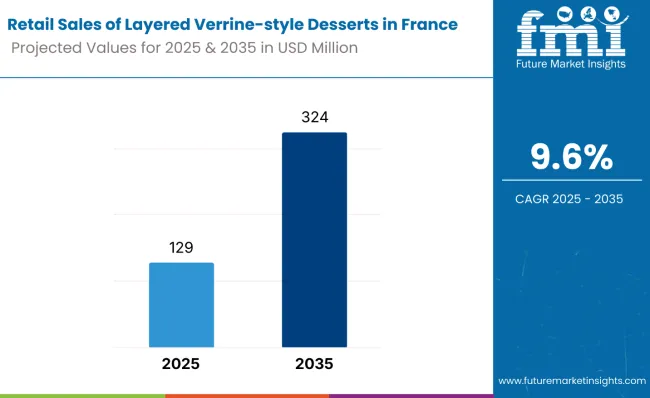
This growth reflects both an expanding consumer base and increased per capita consumption in key metropolitan areas. The rise in demand is linked to evolving dessert preferences, growing appreciation for artisanal presentation, and the premiumization of ready-to-eat dessert offerings.
By 2025, per capita consumption in leading French regions such as Île-de-France, Provence-Alpes-Côte d'Azur, and Auvergne-Rhône-Alpes averages between 2.1 to 2.8 units annually, with projections reaching 4.2 units by 2035. Île-de-France leads among regions, expected to generate USD 97.3 million in layered verrine-style dessert sales by 2035, followed by Provence-Alpes-Côte d'Azur (USD 58.4 million), Auvergne-Rhône-Alpes (USD 48.6 million), Nouvelle-Aquitaine (USD 38.9 million), and Occitanie (USD 32.4 million).
The largest contribution to demand continues to come from sweet layered varieties, which are expected to account for 80% of total sales by 2025, owing to consumer preference for dessert applications, seasonal fruit incorporation, and Instagram-worthy presentation. By container type, glass cups represent the dominant packaging format, responsible for 50% of all sales, while plastic cups decline and paper/compostable options gain ground.
Consumer adoption is particularly concentrated among urban households and millennials seeking premium dessert experiences, with disposable income and culinary sophistication emerging as significant drivers of demand. While price premiums over traditional desserts persist, the average cost per unit has stabilized as production scales increase.
Continued improvements in refrigerated distribution and artisanal positioning are expected to accelerate adoption across affluent suburban households. Regional disparities persist, but per capita demand in high-growth southern regions is approaching levels seen in traditionally strong Parisian metropolitan areas.
The layered verrine-style desserts segment in France is classified across several segments. By format, the key categories include sweet layered desserts featuring fruit, chocolate, and cream combinations, and savory layered options with cheese, vegetables, and protein elements. By container type, the segment spans glass cups offering premium presentation, plastic cups providing convenience and cost efficiency, and paper/compostable cups addressing sustainability concerns.
By distribution channel, the segment covers hypermarkets and supermarkets, discounters, gourmet and specialty stores, and e-commerce platforms. By consumer profile, the segment covers urban professionals, millennial households, premium dessert enthusiasts, sustainability-conscious consumers, and special occasion purchasers. By region, areas such as Île-de-France, Provence-Alpes-Côte d'Azur, Auvergne-Rhône-Alpes, Nouvelle-Aquitaine, and Occitanie are included, along with coverage across all French regions.
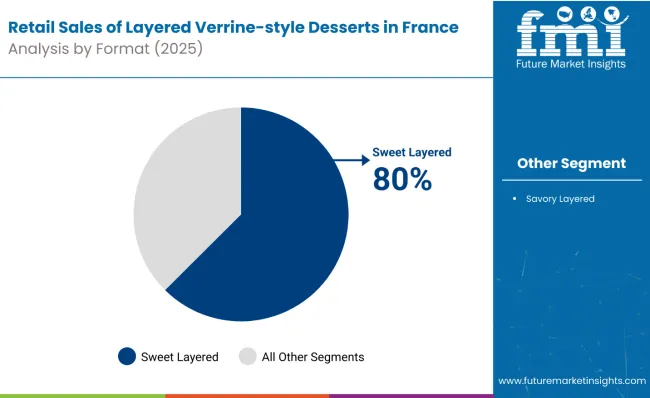
Sweet layered varieties are projected to maintain dominance through 2035, supported by consumer dessert preferences, seasonal ingredient availability, and social media presentation appeal. Savory options continue growing steadily, serving different consumption occasions and meal applications.
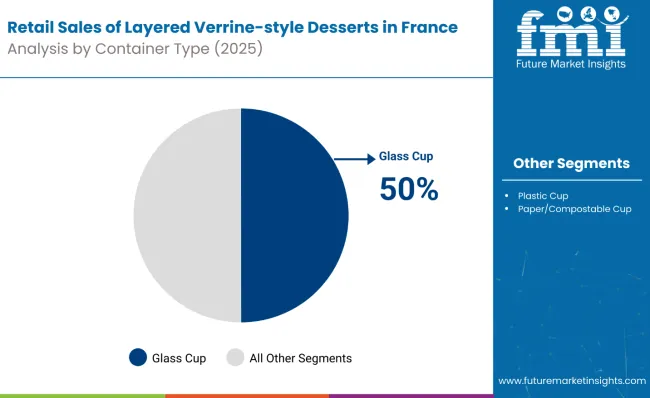
Layered verrine-style desserts in France are packaged across various container formats to match presentation requirements and sustainability preferences. Glass cups are expected to strengthen their primary position through 2035, while plastic declines and sustainable options expand.
Layered verrine-style desserts in France are distributed through diverse retail channels reflecting French shopping patterns. Hypermarkets and supermarkets are expected to maintain the primary position through 2035, followed by specialty stores and growing e-commerce presence.
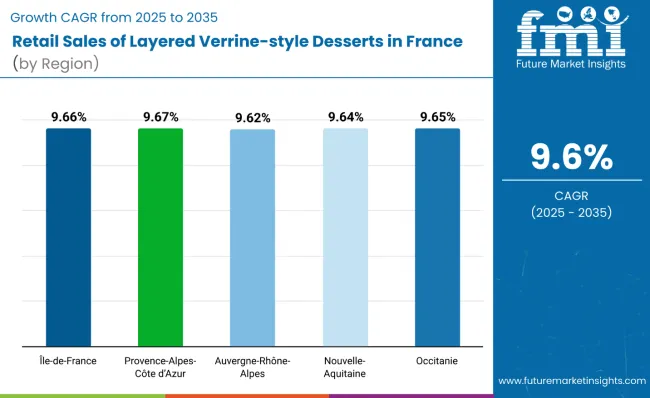
Layered verrine-style dessert sales will grow consistently across French regions, with slight variations based on urbanization levels and disposable income patterns. The table below shows the compound annual growth rate (CAGR) each of the five largest regions is expected to record between 2025 and 2035.
Between 2025 and 2035, demand for layered verrine-style desserts is projected to expand across all major French regions, with remarkably consistent growth rates reflecting the nationwide appeal of premium dessert formats. Among the top five regions analyzed, Provence-Alpes-Côte d'Azur is expected to register the fastest compound annual growth rate (CAGR) of 9.67%, followed closely by Occitanie at 9.65%. This slight acceleration in southern regions is underpinned by tourism influence, Mediterranean lifestyle preferences, and growing affluent resident populations seeking premium food experiences.
Île-de-France maintains strong performance at 9.66% CAGR, supported by high disposable income, sophisticated culinary culture, and extensive premium retail presence across the Paris metropolitan area. The region's established consumer base for artisanal desserts provides a solid foundation for continued expansion of layered verrine formats.
Nouvelle-Aquitaine and Auvergne-Rhône-Alpes are forecast to grow at 9.64% and 9.62% CAGRs respectively, reflecting steady urbanization and increasing consumer sophistication in regional metropolitan centers including Bordeaux, Toulouse, Lyon, and Grenoble. Both regions benefit from growing restaurant culture and premium food retail expansion.
The remarkably consistent growth rates across regions, ranging from 9.62% to 9.67%, indicate that layered verrine-style desserts appeal uniformly across French consumer segments, transcending traditional regional preferences and establishing themselves as a national premium dessert category.
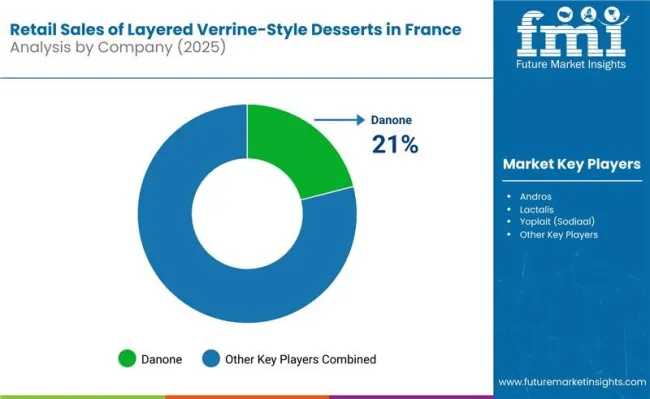
Premium chilled desserts in clear “verrine” cups sit at the cross-roads of pâtisserie tradition and supermarket convenience. Growth is being driven by two distinct strategies. First, dairy majors are premiumising yoghurt and custard lines by adding visible layers of fruit compote, biscuit crumble, or ganache, then pricing them above everyday pots while leveraging factory scale for national listings. Second, artisan-inspired challengers are positioning glass-jar verrines as indulgent, clean-label treats with short ingredient lists and limited-edition flavours. Success hinges on controlling cold-chain logistics, maintaining layer definition during shelf life, and meeting France’s rising scrutiny on additive content.
Competitive intensity is rising as private labels replicate flagship SKU formats within six months, forcing branded players to accelerate flavour rotation and packaging upgrades. Category leaders are investing in single-serve glass that signals sustainability and reusability, while experimenting with plant-based bases to broaden reach beyond traditional dairy. Margin defence now depends on dual capabilities: contract sourcing of high fruit solids at predictable prices and fast innovation cycles that feed new recipes into retailers’ seasonal resets.
Key Developments
| Attribute | Details |
|---|---|
| Study Coverage | France retail sales and consumption of layered verrine -style desserts from 2025 to 2035 |
| Base Year | 2025 |
| Forecast Period | 2025 to 2035 |
| Units of Measurement | USD (sales), Units (volume), Units per capita (consumption) |
| Geography Covered | All French regions; regional-level granularity |
| Top Regions Analyzed | Île-de-France, Provence- Alpes -Côte d'Azur, Auvergne-Rhône-Alpes, Nouvelle-Aquitaine, Occitanie |
| By Format | Sweet layered, Savory layered |
| By Container Type | Glass cups, Plastic cups, Paper/compostable cups |
| By Distribution Channel | Hypermarkets/Supermarkets, Discounters, Gourmet/Specialty stores, E-commerce |
| By Consumer Profile | Urban professionals, Millennial households, Premium dessert enthusiasts, Sustainability-conscious consumers, Special occasion purchasers |
| Metrics Provided | Sales (USD), Volume (Units), Per capita consumption (Units), CAGR (2025-2035), Share by segment |
| Price Analysis | Average unit prices by format and container type |
| Competitive Landscape | Company profiles, brand portfolios, distribution strategies, premium positioning |
| Forecast Drivers | Per capita demand trends, premiumization , sustainability preferences, social media influence |
By 2035, total France retail sales of layered verrine-style desserts are projected to reach USD 324 million, up from USD 129 million in 2025, reflecting a CAGR of approximately 9.6%.
Sweet layered varieties hold the leading share, accounting for approximately 80% of total sales by 2025, while savory layered options represent 22% of the category.
Provence-Alpes-Côte d'Azur and Occitanie lead in projected growth, registering CAGRs of 9.67% and 9.65% respectively between 2025 and 2035, driven by tourism influence and lifestyle preferences.
Glass cups are the dominant container format (50% share by 2025), driven by premium positioning and reusability, while plastic cups decline to 30% and sustainable options reach 12%.
Major players include Danone, Lactalis, Yoplait (Sodiaal), Andros, and Materne, with increasing focus on premium ingredients, sustainable packaging, and seasonal variety expansion.






Our Research Products

The "Full Research Suite" delivers actionable market intel, deep dives on markets or technologies, so clients act faster, cut risk, and unlock growth.

The Leaderboard benchmarks and ranks top vendors, classifying them as Established Leaders, Leading Challengers, or Disruptors & Challengers.

Locates where complements amplify value and substitutes erode it, forecasting net impact by horizon

We deliver granular, decision-grade intel: market sizing, 5-year forecasts, pricing, adoption, usage, revenue, and operational KPIs—plus competitor tracking, regulation, and value chains—across 60 countries broadly.

Spot the shifts before they hit your P&L. We track inflection points, adoption curves, pricing moves, and ecosystem plays to show where demand is heading, why it is changing, and what to do next across high-growth markets and disruptive tech

Real-time reads of user behavior. We track shifting priorities, perceptions of today’s and next-gen services, and provider experience, then pace how fast tech moves from trial to adoption, blending buyer, consumer, and channel inputs with social signals (#WhySwitch, #UX).

Partner with our analyst team to build a custom report designed around your business priorities. From analysing market trends to assessing competitors or crafting bespoke datasets, we tailor insights to your needs.
Supplier Intelligence
Discovery & Profiling
Capacity & Footprint
Performance & Risk
Compliance & Governance
Commercial Readiness
Who Supplies Whom
Scorecards & Shortlists
Playbooks & Docs
Category Intelligence
Definition & Scope
Demand & Use Cases
Cost Drivers
Market Structure
Supply Chain Map
Trade & Policy
Operating Norms
Deliverables
Buyer Intelligence
Account Basics
Spend & Scope
Procurement Model
Vendor Requirements
Terms & Policies
Entry Strategy
Pain Points & Triggers
Outputs
Pricing Analysis
Benchmarks
Trends
Should-Cost
Indexation
Landed Cost
Commercial Terms
Deliverables
Brand Analysis
Positioning & Value Prop
Share & Presence
Customer Evidence
Go-to-Market
Digital & Reputation
Compliance & Trust
KPIs & Gaps
Outputs
Full Research Suite comprises of:
Market outlook & trends analysis
Interviews & case studies
Strategic recommendations
Vendor profiles & capabilities analysis
5-year forecasts
8 regions and 60+ country-level data splits
Market segment data splits
12 months of continuous data updates
DELIVERED AS:
PDF EXCEL ONLINE
Retail Paper Bag Market Size and Share Forecast Outlook 2025 to 2035
Retail Automation Market Size and Share Forecast Outlook 2025 to 2035
Retail Logistics Market Size and Share Forecast Outlook 2025 to 2035
Retail Displays Market Size and Share Forecast Outlook 2025 to 2035
Retail Colocation Market Size and Share Forecast Outlook 2025 to 2035
Retail Warehouse Management Systems Market Size and Share Forecast Outlook 2025 to 2035
Retail Analytics Market Analysis by Solution, Function, Enterprise Size, Deployment Model, Field Crowdsourcing, and Region Through 2035
Examining Market Share Trends in the Retail Paper Bag Industry
Retail Signage Market
Retail Digital Signage Market
India Retail Mineral Turpentine Oil Market Growth – Trends & Forecast 2024-2034
Retail Clinics Market Analysis – Size, Share, and Forecast Outlook 2025 to 2035
Retail Printers Market Growth - Trends & Forecast 2025 to 2035
Retail Printers and Consumables Market Growth - Trends & Forecast 2025 to 2035
Retail Vending Machine Market Analysis - Size, Share, and Forecast 2025 to 2035
Market Share Distribution Among Retail Vending Machine Suppliers
Retail Sourcing And Procurement Market Size and Share Forecast Outlook 2025 to 2035
Europe Retail Paper Bag Market Trends – Growth & Forecast 2023-2033
Retail Glass Packaging Market Size and Share Forecast Outlook 2025 to 2035
Retail Glass Packaging Industry Analysis in Europe and the Middle East and Africa - Size, Share, and Forecast 2025 to 2035

Thank you!
You will receive an email from our Business Development Manager. Please be sure to check your SPAM/JUNK folder too.
Chat With
MaRIA